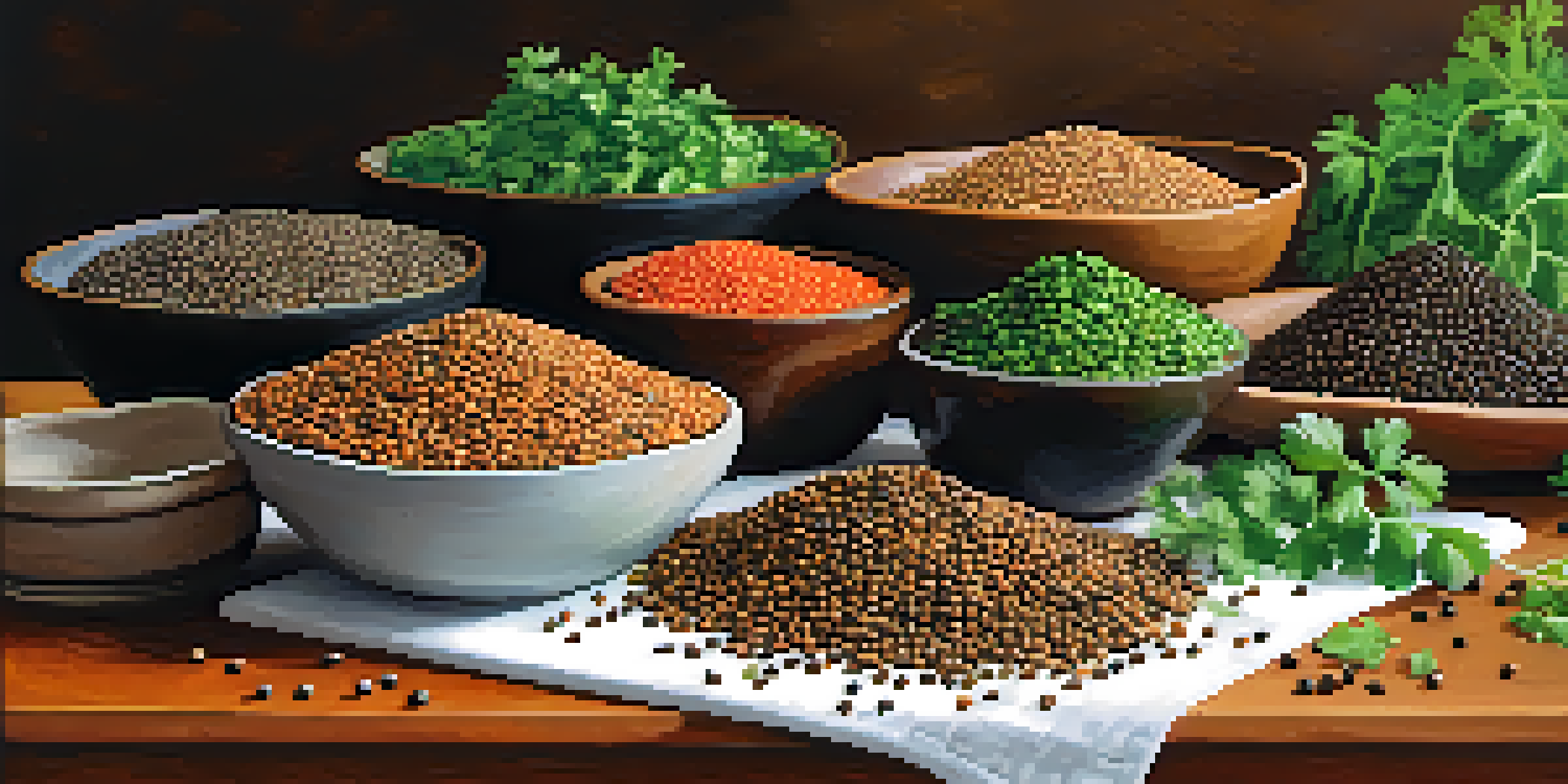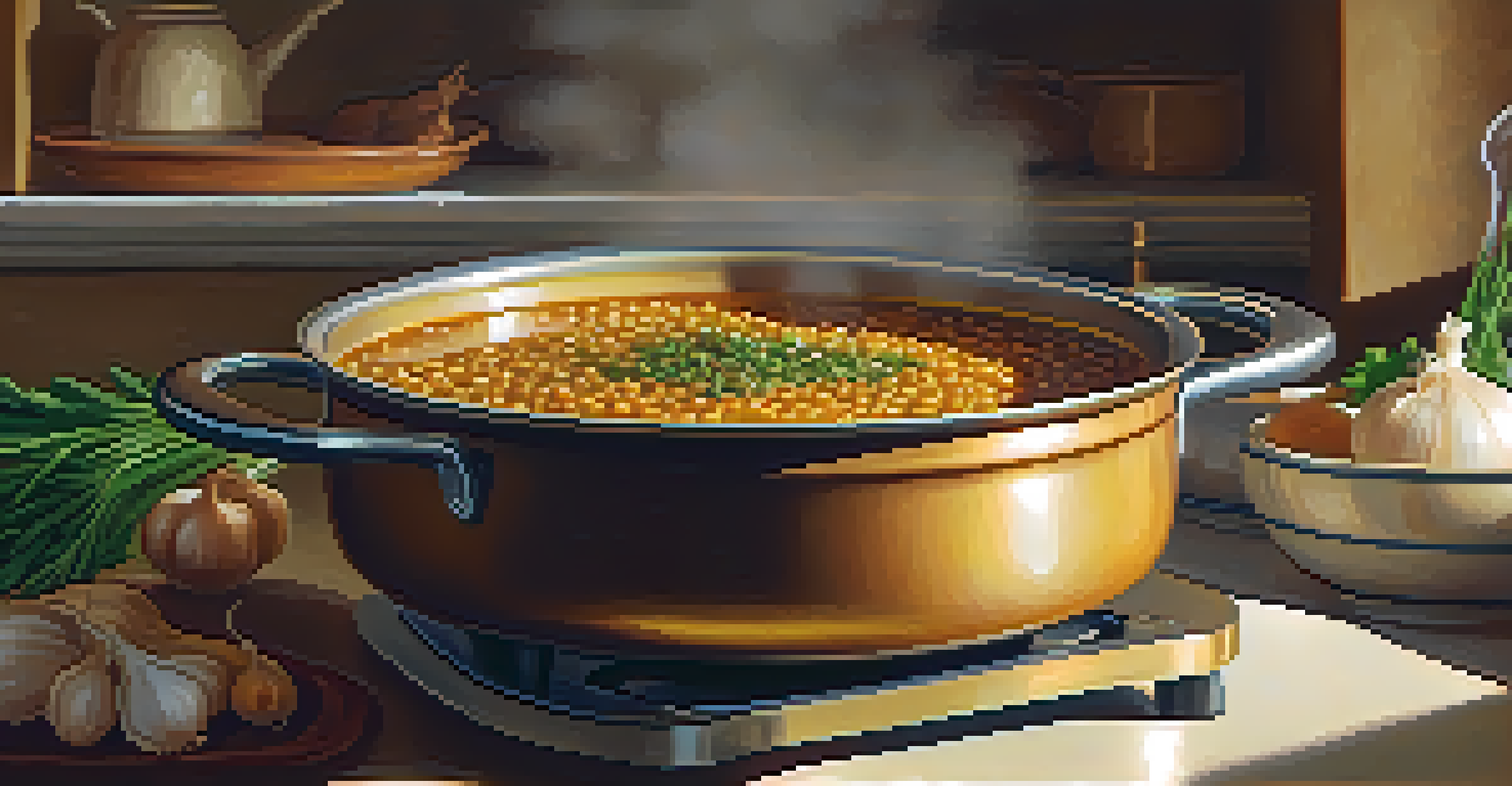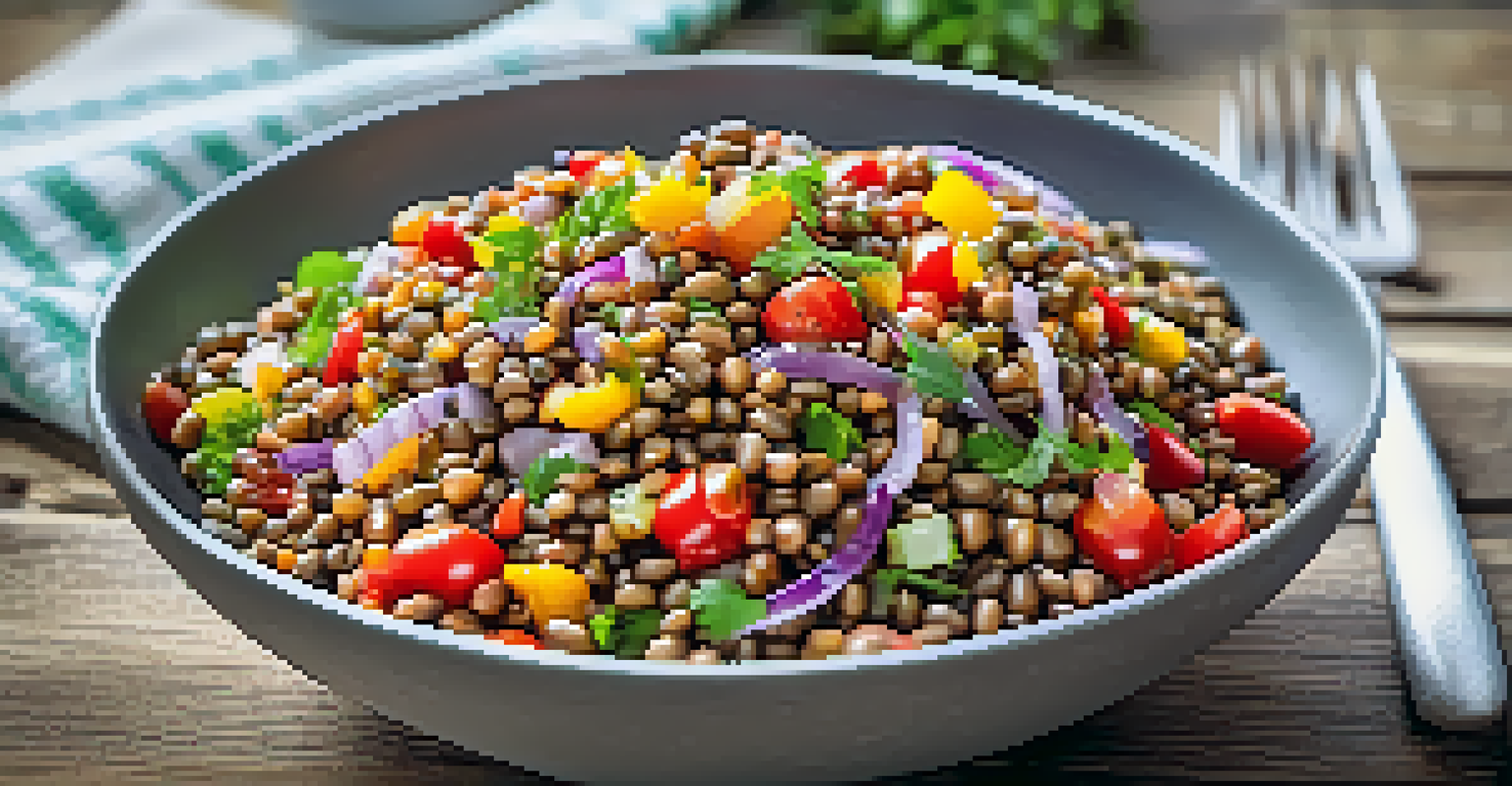How to Prepare Lentils for Flavorful Vegetarian Recipes

Understanding Lentils: Types and Benefits
Lentils are a versatile legume, perfect for a variety of dishes. They come in several types, including green, brown, red, and black, each offering unique flavors and textures. Brown lentils are hearty and hold their shape well, while red lentils cook down to a creamy consistency. Packed with protein, fiber, and essential nutrients, lentils are a fantastic addition to any vegetarian diet.
Lentils are the perfect food: nutritious, versatile, and easy to cook.
In addition to their nutritional benefits, lentils are also quick to prepare. Unlike other legumes, they don’t require soaking, making them a convenient choice for busy weeknights. Their ability to absorb flavors makes them a wonderful canvas for spices, herbs, and sauces, allowing you to create a wide range of dishes. Whether you're crafting a comforting stew or a refreshing salad, lentils can elevate your meal.
Understanding the different types of lentils helps you choose the right variety for your recipe. Green and brown lentils are great for salads and side dishes, while red lentils are ideal for soups and curries. This knowledge not only enhances your cooking skills but also empowers you to experiment with different flavors and textures in your vegetarian recipes.
Prepping Lentils: Rinsing and Sorting
Before cooking lentils, it's important to give them some TLC by rinsing and sorting. Start by pouring the lentils into a fine mesh strainer to remove any dirt or debris that may have made their way in during processing. A quick rinse under cold water helps wash away any dust, ensuring your lentils are clean and ready for cooking.

Sorting is equally crucial. While lentils are typically cleaned before packaging, small stones or other impurities can sometimes sneak in. By spreading the lentils out on a flat surface, you can easily spot any unwanted items. This step not only guarantees a smoother cooking process but also ensures that every bite of your dish is as enjoyable as possible.
Lentil Types and Their Benefits
Different types of lentils, such as green, brown, red, and black, offer unique flavors and textures, making them a nutritious addition to various vegetarian dishes.
Taking the time to rinse and sort your lentils might seem tedious, but it sets the stage for a great meal. Clean lentils will cook more evenly and absorb flavors better, enhancing the overall taste of your dish. So, don't skip this vital prep step—it's a small investment of time that pays off with delicious results!
Cooking Methods: Stovetop, Instant Pot, and More
Lentils can be cooked using various methods, each yielding different results. The stovetop method is the most common; simply combine rinsed lentils with water or broth in a pot, bring to a boil, then simmer until tender. This method allows for greater control over the cooking process, making it easy to check for doneness and flavor adjustments along the way.
The beauty of lentils is that they can adapt to a variety of cuisines.
For those with a busy lifestyle, the Instant Pot is a game changer. Cooking lentils in an Instant Pot drastically reduces the time needed, allowing you to achieve perfectly cooked lentils in a fraction of the time. Just a few minutes of pressure cooking can transform your ingredients into a delicious base for soups, stews, or salads.
If you're looking to infuse your lentils with extra flavor, consider toasting them before cooking. Simply dry-toast rinsed lentils in a pan for a few minutes until fragrant. This step enhances their nuttiness, making your final dish even more delicious. Regardless of the method you choose, cooking lentils is a simple and rewarding process.
Flavoring Lentils: Herbs, Spices, and Broths
One of the best aspects of cooking lentils is their ability to absorb flavors. To enhance their taste, consider adding aromatics like onions, garlic, or ginger to your cooking liquid. These ingredients create a flavorful base that permeates the lentils as they cook, resulting in a dish that's bursting with flavor.
Spices are another excellent way to elevate your lentils. Experiment with cumin, coriander, or smoked paprika to add depth and warmth. For a kick, try incorporating chili powder or cayenne pepper. The beauty of lentils is that they can adapt to a variety of cuisines, so don’t hesitate to get creative with your spice combinations.
Easy Lentil Prep for Cooking
Rinsing and sorting lentils before cooking ensures they are clean and free from impurities, leading to a more enjoyable dining experience.
Finally, using broth instead of water is a simple yet effective way to infuse your lentils with even more flavor. Vegetable broth, in particular, complements the earthiness of lentils beautifully. By combining these techniques, you can transform a basic lentil dish into a vibrant and delicious meal that will satisfy both vegetarians and meat lovers alike.
Creative Ways to Use Cooked Lentils in Dishes
Cooked lentils are incredibly versatile, lending themselves to a variety of dishes. One popular option is to use them in salads, where their firm texture adds substance and protein. Toss cooked lentils with fresh vegetables, a zesty dressing, and some herbs for a refreshing and nutritious meal.
Another fantastic way to utilize lentils is in soups and stews. They not only add heartiness but also help thicken the broth, creating a satisfying texture. Whether it's a spicy lentil soup or a cozy stew, cooked lentils bring both flavor and nutrition to the table.
Don't overlook the potential of lentils in vegetarian burgers or meatballs. When blended with spices, breadcrumbs, and vegetables, they form a great meat alternative that’s packed with protein. The possibilities are endless, and with a little creativity, you can incorporate lentils into nearly any meal!
Storing Leftover Lentils: Tips and Tricks
If you find yourself with leftover cooked lentils, you're in luck! They can be stored in the refrigerator for up to a week, making them a great option for meal prep. Simply transfer them to an airtight container and refrigerate. When you're ready to use them, just reheat in the microwave or on the stovetop.
For longer storage, consider freezing cooked lentils. Spread them out on a baking sheet to cool, then transfer to a freezer-safe container or bag. This method prevents clumping, allowing you to easily grab just the amount you need for future meals. Frozen lentils can last for several months, making them a convenient staple.
Flavoring and Using Cooked Lentils
Lentils absorb flavors well, making them versatile for salads, soups, and even vegetarian burgers when seasoned with herbs, spices, and broths.
When reheating lentils, add a splash of water or broth to help restore moisture. They may dry out slightly during storage, but this simple trick will bring them back to their original, delicious state. With proper storage, those leftover lentils can become the foundation for a quick and easy meal later on!
Troubleshooting Common Lentil Cooking Issues
Even the most seasoned cooks can encounter issues with lentils. One common problem is overcooking, which can result in mushy lentils. To avoid this, keep a close eye on the cooking time and taste them periodically. Knowing the ideal cooking time for different types of lentils can also help you achieve the desired texture.
Another issue might arise if your lentils don’t seem to absorb flavors. This can happen if they’re cooked in plain water without any seasoning. Be sure to add salt, spices, or a flavorful broth early in the cooking process to enhance their taste. Remember, lentils are like sponges—they soak up whatever you add to them.

Lastly, if you find your lentils are still firm after the recommended cooking time, simply add a bit more liquid and continue cooking. Sometimes, factors like altitude or the age of your lentils can affect cooking times. With these troubleshooting tips, you’ll be well-equipped to handle any challenges that come your way while cooking lentils!